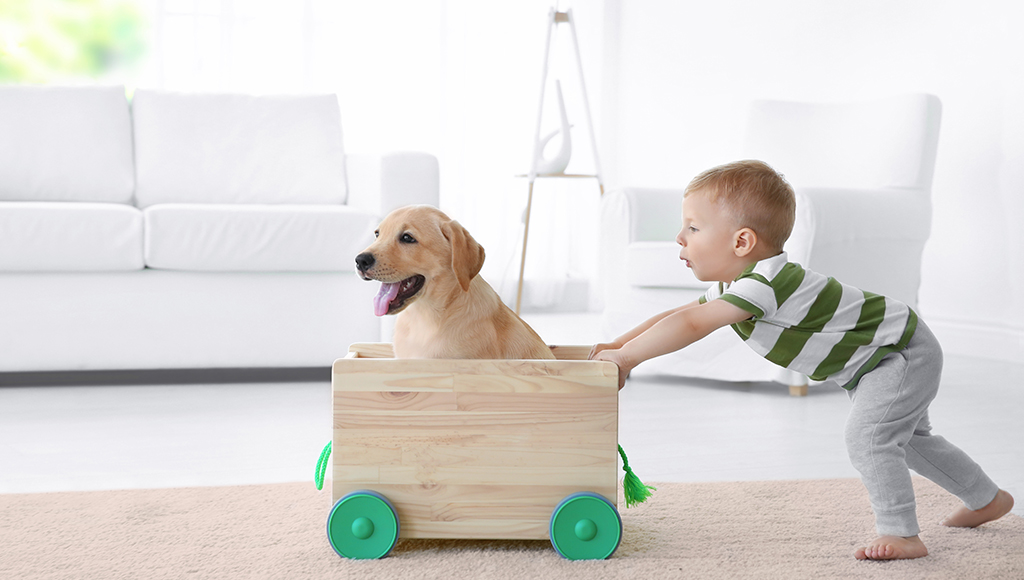Teaching Dog Safety to Children
This may be one of the most important lessons you will ever teach your child.

All children should be taught to respect other living creatures, be they animal or human. From birth, children need to learn that some things are just not allowed around animals, and "always be gentle" should be a common household phrase. Even if your household does not contain animals, your children should still be taught calm, gentle behavior. One day they may encounter an animal, whether it is somebody else's pet in a controlled environment, or a random meeting on the street with a strange dog.
Teaching children the "do's and dont's" regarding animals is among one of the most important lessons you will ever teach them. Animals are everywhere and although many are domesticated, this does not automatically make them safe, especially around children whose behavior can be unpredictable. In the U.S. alone, 1-2 million dog bites occur annually.
Today many homes are raising children along with the family dog. Naturally kids delight in hugging, petting, and playing with their pets. Unfortunately, many children grow up believing that all dogs are gentle and friendly like their pet, and commonly fall victim to a dog attack, simply because they were never taught when it's not okay to approach a dog.
IMPORTANT BASICS
- Always Be Gentle
So many parents don't pay close enough attention to how their children interact or play with the family dog. A gentle hand will carry children through so many different situations in life; not only their interactions with animals.
When your child approaches a dog, show them how to pet the animal "gently", in a calm and friendly manner. Don't let them pull on the animal's ears or fur, but teach them to "stroke" the animal slowly. Gentle rubbing of the fur, or feeling of the ears is okay, but should always be supervised. Remember to make sure the child does not squeeze or twist handfuls of fur, and make sure they know that a tail is not a handle or toy to be held. If your child normally has a heavy hand, don't use a real dog for the first time; use a stuffed animal instead. A dog might not be as tolerant or patient as you'd think with a grabbing hand. - The Right Approach
This is extremely important! From the moment a child is old enough to understand, you must teach them how to approach a dog properly! What is the right way to approach a dog?
- Approach his owner first and always ask permission! The owner knows his dog better than anyone else, and his presence will help ensure that the dog will remain calm.
- Say "hello" after permission is given.
- Approach slowly, and do not ever run up to the dog.
- Hold your hand out, palm down, and let the dog sniff you and give him time to decide how close he wants to get.
Many dogs love attention, but the first few moments of every new meeting is critical. A correct approach will likely have the new dog sidling in closer for hugs and kisses. -
Fear Factor
Please don't bring your children up to fear all dogs, even if you do. A child who is taught fear will react to a strange dog in a way that may make the situation worse. Instead, teach them to respect dogs and all other animals, and not run from them. -
Meeting A Strange Dog With No Owners Present
It is very important to keep a cool head during these moments. Do not do what your instincts may tell you to do. The first instinct is often "scream and run", but please do not do this. Instead, using a loud, firm voice, tell the dog to "go home". If he doesn't leave, don't panic.
What is the dog doing? Is he just watching you, curiosity in his posture (ears perked, tail wagging, relaxed stance)? If this is how he looks, just walk away calmly. Once again, do not run.
Is the dog standing in a threatening manner? Ears laid back along his head, his body tense, his tail up (may or may not be wagging slowly, don't be fooled): this a threatening posture. Tell him to "Go lay down" in a firm voice, do not yell, do not scream. Any sudden move on your part may trigger an attack. Start to walk away slowly. Do not make any sudden moves. If he starts to advance on you, and lunges, drop into a "turtle" position, and yell for help. Parents, if you come across your child in this position, do whatever you have to do to get the dog away. -
Never Run Away From A Dog
Running from a dog will only trigger a "prey" response, and a dog that may have been content to sit and watch you will now suddenly chase you. Even a dog whose only intent is to "play" may cause devastating results when the "prey" is caught. -
Never Approach a Dog When He is Eating
Parents, this should be common sense, and every child should be taught this, whether you have pets in the home or not.
Dog Owners, if your dog is food protective, please take the time to train him out of it. It may seem like a trivial thing now, but as the dog gets older, it may be something you wish you'd taken the time to teach him, as he gets older. -
Parents Never Leave Your Young Child Unattended With a Dog!
Accidents happen in the blink of an eye, and even the gentlest family dog will bite if he is in pain, or if he has just "had enough".
Parents, please don't hesitate to call animal control if a loose dog ever threatens you or your child. Loose dogs are a menace, and irresponsible owners should be held accountable. Dog owners that do not care where their dog goes and what he does should not be dog owners, period.
SAFETY TIPS TO TEACH CHILDREN
Start teaching your children the following safety guidelines regarding dogs when they are quite young, and continue reinforcing these precautions frequently until you are absolutely certain they fully understand them and the importance of adhering to them at all times:
- Never run up to a dog.
- Never attempt to touch a neighbor's dog or any unfamiliar dog
through a fence.
- Never touch a dog that is growling, showing his teeth, or
barking hysterically.
- Young children must never approach dogs without adult
supervision.
- Always hold your hand out first and allow the dog time to
sniff your hand fully before making any other moves or gestures.
This helps reassure the animal that you are not aggressive, even
though you are unfamiliar to them.
- Never grab at a dog, even if he is familiar with who you are.
This is always seen as aggression and they will respond
accordingly.
- Don't approach a dog that is a watch dog protecting his
property. He has been trained not to allow intruders and will
defend the property any way he can.
- Never attempt to touch a dog that is eating or in possession
of a bone or a treat of some sort, even if you gave him the bone
or treat initially. He will view this has an act of aggression,
even if it is not intended as
such.
- Never hurt the animal by pulling it's tail or its fur. The
dog will protect itself and do what it has to to prevent pain or
attack, even from someone it knows.
- If a dog is leashed, always ask the dog's owner for
permission to pet it before doing so.
- Keep your face away from a dog's at all times, when
approaching or playing with them, as this confuses them and may
be misinterpreted as aggression.
- Don't make loud noises or sudden moves when approaching a
dog, even your own, as this may startle or frighten them, and
they will act to protect themselves.
- Always speak in a soft, and gentle tone.
- If a dog is chasing you, stop running, as this only
encourages him to chase you. Avoid eye contact with an aggressive
dog, and back off slowly and non-threateningly.
- Do not touch, or ever attempt to touch the animal's eyes.
Ready to start saving money on pet wellness care?
Then take a look at Mint Wellness, the pet wellness plan that provides fast reimbursement on routine pet care. Save on vaccinations, wellness exams, preventatives, dental, and more!
Learn More


